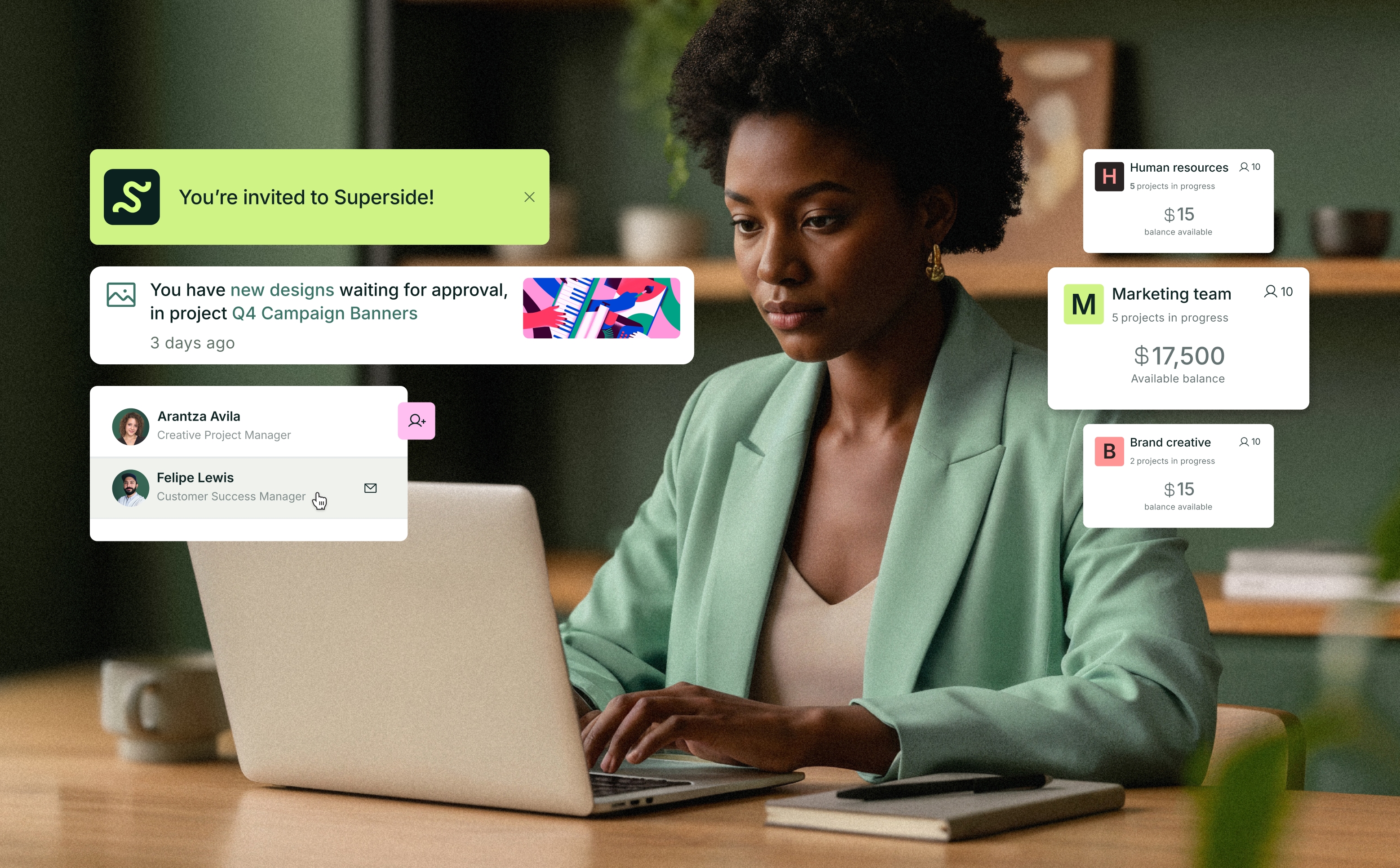
Video is one of the most powerful and influential methods you can use to boost your brand. Platforms like TikTok, Instagram, and YouTube have blown the doors wide open for video to take over the world of advertising, and brands are starting to really pay attention.
But if video marketing is so great, why are so many companies averse to its use? It can seem expensive, technically challenging, unapproachable, and difficult to measure success for. That’s why you might not have experimented with video—but it means your competitors might not either. And that leaves an opportunity to place a smart bet.
Here's what you'll learn
Video supercharges your SEO
Step 1: Don't Get too Fancy
Step 2: Recycle, Repurpose, and Revitalize
Step 3: Become Friends With Stock Video
Step 4: Think of the Complete Picture
Video Supercharges Your SEO
Along with paid video advertising, brand promotion, and even the antiquated TV ad, there are also a myriad of other reasons why you should be picking up the camera and upping your script-writing skills. One reason, which we’ve discussed before, is the sheer power of video advertising to boost your content’s SEO rankings.
Google is really pushing video forward in its SEO algorithms. You can see it for yourself! Just type in any basic “How to” search query, like “how to change a tire”, “how to get chewing gum out of your hair” or “how to film an ad on my iPhone” and you’ll see a lot of video results popping up.
Google is pushing video forward for a lot of reasons (mainly for advertising and revenue purposes) but it’s important for you and your company to start exploring video advertising. Without it, you’re leaving a huge advantage for yourself and your brand just lying on the table.
Think of it like a zombie apocalypse. You’ve got your katana (written content) and crossbow (paid ads) buckled and ready, but you’re leaving the sawn-off shotgun (video) sitting right there for someone else to use.
Don’t leave it for someone else to dive in and eat up your market space and get familiar with the world of video marketing before it’s too late.
But, how do you even begin your foray into video marketing?
Well, we’re going to show you exactly how.
P.S: Keep reading to get some expert video marketing advice from our friends (and client!) over at Storyblocks.
Step 1: Don’t Get Too Fancy
It’s like any foray into a new realm of expertise: people always want to get the fancy gear so they can look the part. Companies diving into the world of video are incredibly quick to splurge cash on new equipment that they don’t need and that nobody in the company knows how to use.
Don’t do this.
You, most likely, have a high-resolution camera sitting in your pocket right now. Whip out your smartphone and get experimenting.
Offices are a great environment for shooting video, and you will most definitely have some (reluctant) extras and co-stars to throw into the mix. It’s something we do ourselves at Superside. If you’re looking for in-office video ideas, just check out our YouTube channel, there are plenty of ideas for you to borrow or rip off (it’s okay, you have our permission).
Take some time to think about what aspect of your product or service you want to market, and then just start experimenting in front of the camera.
- Do you want to just be a talking head giving advice?
- Are you looking to do a skit or a situational bit?
- Does your ad just need some background B-roll with a voiceover?
It is very, very common for people starting out in video marketing to get stars in their eyes, get obsessed with overambitious ideas, and eventually create a tangled mess of an ad that completely misses the message.
Just remember your product’s unique selling point, your brand’s aesthetic, and the tone of voice you want to promote, and start filming.
Once you’ve created your first video ad, you’re most likely going to think “what now? How do I keep up a consistent pace?”
Well, we’ll give you the answer
Step 2: Recycle, Repurpose, and Revitalize
No matter what size your company is, you most likely have some kind of promotional or marketing material lying around.
A blog article, an advertisement, an interview, something. Take this and repurpose it.
Modern video marketing has a fast, vicious pace. If you’re not uploading a YouTube video once a week, a TikTok video once a day, a plethora of Instagram reels, and some Facebook posts for the oldies, your brand is going to be drowned out.
Before you even launch your first video, take some time to look through your current marketing material and see what you can repurpose into a fast, high-quality video ad.
Blog articles are your best resource for this.
It is far easier to repurpose a blog article into a script versus creating an entirely new piece of content to be reviewed, re-edited, and rewritten several times.
Sift through your blog and find the best videos for you to repurpose.
Then, you can move on to webinars, live events, and interviews, taking all the prime snippets and editing them to suit your desired video length and medium.
Be shameless in your recycling of old content. After all, it’s a new medium you’re using with a fresh approach. Even if people have seen it before, they’ll appreciate it again thanks to the new coat of editing paint you’ve given it.
But what happens when you need something outside of your company’s ability?
What about a Tokyo skyline? Or a reel of some deer frolicking in a field? An old man struggling up the stairs?
Naturally, you’re not going to send the new intern out with his iPhone to film grandpa Jerry, so what can you do?
Step 3: Become Friends With Stock Video
Stock video is one of the most underutilized tools in the world of video marketing. Instead of that shakey video of grandpa Jerry, you could have millions, if not billions, of video files at your disposal.
But how can you start?
We know that stock video can be a bit of a minefield for many, which is why we spoke to Ben Abraham, Senior Manager of Brand Marketing at Storyblocks.
Storyblocks is an industry leader in stock video services, offering clients a wide selection of high-quality stock videos at an accessible price, which is why we're thrilled to work with them and give them a leg up in design.
To give you a better understanding of how to use stock video, we asked Ben a few questions.
Why are stock videos a better choice than people filming their own content?
Video production often requires expensive location permitting, exhaustive set design, and extensive coordination of crew and talent.
Custom production can be expensive, time-consuming, resource intensive, and unrealistic for many teams that are looking to scale.
Stock media enables teams to gain access to an exhaustive library of multimedia materials without that hassle. Let’s say that you work within an in-house marketing department and need to produce a video that requires a rapid turnaround time. Or, perhaps you’re a social media manager that needs to scale the volume of content that you are producing.
Stock video can be your friend. It help creatives to create video faster, easier and more efficiently than ever before. Our data suggests that a team of 10 using Storyblocks saves over 1750 hours per year through the useof stock media assets and creative workflow tools.
One of the key components that differentiates stock media from custom production is the sheer access to information.
What is the one thing people constantly overlook when it comes to using stock videos?
It’s becoming exceedingly difficult to scale video production output without stock media.
Marketers and creators should be reminded that having access to a stock media library and rapid video creation tools can scale their video creation output and speed to market.
Design and production teams are overloaded with production work that slows them down and limits their ability to focus on high-impact work.
Stock can media save teams valuable time.
Beyond providing video, audio and image assets, libraries are populated with customizable templates (i.e. title cards, lower thirds, transition effects, CTA elements, color presets, hand-drawn elements, etc.) that are time intensive for teams to produce from scratch.
Also, stock media can also be used effectively to assist the storyboarding phase of a production and help provide clearer visualization of an item that is currently ‘proof-of-concept’.
A stock media library allows for experimentation, testing, and visualization of an entire project. With access to a stock media library, your team can increase their workflow efficiency in an actionable way.
How can a team add a more unique touch to their use of stock videos?
Downloading stock assets is just the beginning of incorporating these elements into your workflow. Many tools, such as Storyblocks’ Maker will allow you to use assets from stock media libraries, and edit them easily.
Additionally, marketers and creators can modify stock assets by aligning them with your organization’s brand guidelines or other visual styles.
PS: Getting on brand is something Superside can help with!
Step 4: Think of the Complete Picture
So you have your stock videos, your repurposed blog articles, and your camera at the ready. You’ve filmed all your scenes, and you’re ready to get editing.
But who’s going to edit it?
Is there anyone on your team with that experience?
What about checking the sound levels?
Title cards?
CTAs?
What about adding Motion Graphics?
Filming your video is step one of the video creation process, and sometimes it’s the easiest.
So how are you going to maintain the publishing cadence that you need while also maintaining quality, style, and consistency?
Superside offers an end-to-end video marketing service. Taking your videos and creating professionally edited, finely tuned content that is ready for you to share with your audience.
What sets Superside apart is that we don’t just offer you the design service, we can also offer you the ideas. Not sure how to market your product or service? Struggling to create a brand aesthetic that appeals to your target audience?
Superside can help you with that.












